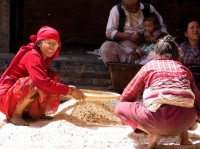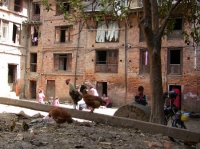This section gives a complete overview of the Ayurvedic understanding of disease etiology, i.e. how diseases are grouped and then differentiated according to Ayurvedic principles for proper treatment. There are about 700 diseases identified according to the theory of Tridosha Siddhanta. The classifications follow the categories set up in the early Ayurvedic classic texts of Charaka and Susruta, and expanded in the later works, such as the Madhava Nidana, published circa 700 CE.
 Based upon this, and after more than 40 years of clinical medical practice, the senior author has established concurrence or congruence between the classic Ayurvedic diseases with known Western diseases. The process of doing this began in the 1950’s and continued until the writing of this book. We term this process congruency because exact concordance is not possible. This is not to say that it is a matter of opinion. In 1996 the diagnosis of 76 Ayurvedic eye diseases based upon written symptomatology was checked by board-certified ophthalmologist Robert Abel, Jr., and the resultant Western medical terms assigned to the Ayurvedic set of symptoms was found to be highly accurate.
Based upon this, and after more than 40 years of clinical medical practice, the senior author has established concurrence or congruence between the classic Ayurvedic diseases with known Western diseases. The process of doing this began in the 1950’s and continued until the writing of this book. We term this process congruency because exact concordance is not possible. This is not to say that it is a matter of opinion. In 1996 the diagnosis of 76 Ayurvedic eye diseases based upon written symptomatology was checked by board-certified ophthalmologist Robert Abel, Jr., and the resultant Western medical terms assigned to the Ayurvedic set of symptoms was found to be highly accurate.
There are several issues necessary to fully understand this process of disease classification. In some cases the Ayurvedic disease is so closely identical to a Western disease that there is no question as to its equivalency. Arthritis of the hand (viswachi) is a good example. In other cases the diseases are similar enough that congruency is a better term. For example, fevers classified before the advances of modern microbiology can share symptoms with specific types of fever encountered in modern practice, but there is no certainty that the viral or bacterial agent present in both modern an ancient times is identical. In some cases a single Western disease is divided by Ayurveda into several groups and vice versa. Finally there are Ayurvedic diseases that have no Western equivalent. An example here is Abhicharaja jwara, deined as fever caused by black magic. In this case the disease can only be given a descriptive term.
In addition to this classification, brief descriptions of each disease and standard methods of treatment are also presented. These general descriptions of the treatments methods used for specific diseases will mention specific treatments and/or the general categories of herbs to use, such as digestive herbs or antipyretic herbs.
 For many diseases, proper treatment requires use of specific treatments or formulas combined with the standard treatments for Vata, Pitta and Kapha. Normally the choice of which general treatments to use and which specific treatments to choose from a list, as well as the order in which to use them, depends upon the skill and judgement of the physician. For example, if a standard herbal formula is given for bronchitis, one method is to combine some anti-Vata herbs to the formula if it is Vataja bronchitis, anti-Pitta herbs if it is Pittaja bronchitis, and anti-Kapha herbs if it is a Kaphaja bronchitis. It is also possible to use standard formula(s) alone, or to use both standard and specific treatments side by side.
For many diseases, proper treatment requires use of specific treatments or formulas combined with the standard treatments for Vata, Pitta and Kapha. Normally the choice of which general treatments to use and which specific treatments to choose from a list, as well as the order in which to use them, depends upon the skill and judgement of the physician. For example, if a standard herbal formula is given for bronchitis, one method is to combine some anti-Vata herbs to the formula if it is Vataja bronchitis, anti-Pitta herbs if it is Pittaja bronchitis, and anti-Kapha herbs if it is a Kaphaja bronchitis. It is also possible to use standard formula(s) alone, or to use both standard and specific treatments side by side.
Editor’s Note: Dr. Mana devised a unique correspondance between the basic components of physiological function with the activities of the doshas. In particular, Dr. Mana saw a correspondence between blood supply and the function of the doshas. In his scheme, the supply of nutrition in the blood through the arterial system is correlated with Kapha dosha, whereas the elimination of cellular wastes into the venous system is correlated with Pitta. Regulation of the movement of blood in and out of the tissues is facilitated by the nervous system, which corresponds with Vata dosha. Throughout this text, Dr. Mana uses the terms arterial, venous and nervous systems as the basic physiological manifestations of Kapha, Pitta and Vata respectively, and thus should be interpreted on this basis.
0 Responses to “Classification and Treatment of Disease”